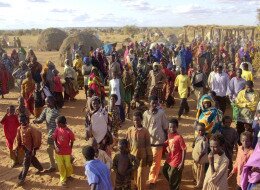Kenya Recruits Somali Refugees To Fight Islamists Back Home In Somalia
 Hagadera Refugee Camp, Kenya–For months, 18-year-old Ahmed Abdullahi had dodged the mortar shells that whizz daily through Mogadishu, the war-ravaged capital of Somalia. The one that finally drove him from Somalia tore though his family’s house and ripped a cousin to bits, splattering Ahmed with blood and body parts.
Hagadera Refugee Camp, Kenya–For months, 18-year-old Ahmed Abdullahi had dodged the mortar shells that whizz daily through Mogadishu, the war-ravaged capital of Somalia. The one that finally drove him from Somalia tore though his family’s house and ripped a cousin to bits, splattering Ahmed with blood and body parts.
Dodging bullets and bandits, Ahmed fled with his mother across Somalia’s southern border to Hagadera, one of three refugee camps in the deserts of Dadaab, in northeast Kenya. Ahmed obediently fetched firewood and water for his mother but couldn’t find a job. Then one day in early October, he vanished. Friends said a recruiter had lured him into a covert force of Somali refugees that the Kenyan government is training to help Somalia’s internationally backed transitional government fight the extremist Islamist group Al-Shabaab.
In recent weeks hundreds of young men and boys from the Dadaab refugee camps have been secretly recruited for the force, lured with false promises of lavish pay and claims of backing from the United Nations and the United States. By the time the refugees learn their pay will be a fraction of what they were promised, and that they will be hastily trained for frontline combat, their cell phones and identity papers have been confiscated.
The recruitment drive is being organized by Kenyan government officials–who have issued numerous but contradictory denials about their role–as well as exiled Somalis living in Kenya. Many western and regional governments share the goal of routing Al-Shabaab, a group with some links to Al-Qaeda. But in addition to luring recruits through deception, the covert program directly contravenes principles of international law that bar military activity in refugee camps. Such camps are meant to be purely humanitarian spaces where refugees can escape the violence that drove them to flee. And some recruits said children under 15 appear to be among the ranks, which would be a war crime. The covert recruitment drive also targets Kenyans of Somali heritage in marginalized, northeast Kenyan Somali communities such as Dadaab town, located near the refugee camps.
Who is funding the secret force remains a mystery. What is clear is that some of the world’s most vulnerable and traumatized refugees are being lured back to the very conflict they narrowly escaped.
“After all that we went through in Somalia, I never thought that that my son would come to a peaceful country like Kenya only to face the same dangers here,” said Ahmed’s mother, Miryama. (As with all refugees in this article, we have changed her name to protect her from possible reprisal). “This is the same as kidnapping our sons,” said Miryama’s friend Fatima, whose son also joined the force.
What is also clear is that the drive could backfire and broaden the already significant regional and international dimensions of the conflict in Somalia, where 18 years of conflict have killed thousands of civilians, displaced millions of others and left the country stateless and ravaged. Al-Shabaab has already threatened retaliation if Kenya recruits Somalis to fight against it. Meanwhile, al-Shabaab and other Islamist insurgent groups are also recruiting in refugee camps and in other Somali immigrant communities in Kenya.
Al-Shabaab, which the United States has designated a terrorist organization, is importing fighters from Afghanistan, Pakistan, Chechnya, and even young Somali-Americans from Minnesota and Washington State to bolster its forces. Along with other Islamist insurgent groups such as Hisbul Islam, it has trapped the country’s UN- and US-backed Transitional Federal Government into a tiny sliver of Mogadishu. The Transitional Federal Government would probably lose even that scrap of turf within days if it weren’t protected by a UN-sponsored force of African Union peacekeepers called AMISOM, which sometimes fires indiscriminately at opposition-controlled northern Mogadishu, killing civilians, when Al-Shabaab attacks it.
In recent years the US has stepped up involvement in Somalia, using drones and helicopters to conduct targeted killings of alleged terrorists, including a key Al-Qaeda suspect in September. In what it called a reprisal, Al-Shabaab days later staged a suicide bombing at the AMISOM base in Mogadishu, killing 21 people. The Obama administration also has shipped arms to the transitional government’s beleaguered soldiers, obtaining a UN exemption from an international ban on weapons sales to Somalia, despite questions as to how the weapons are being used and evidence that many of them end up on the open market. Ethiopia, Somalia’s most powerful neighbor, carried out a bloody, two-year military intervention in Somalia in a failed effort to entrench the Transitional Federal Government. Its forces withdrew from Somalia in late 2008 but still cross the border.
Kenya has been the victim of Al-Qaeda attacks in the past and its government has become increasingly fearful of Shabaab incursions across its porous northeast border. But as one worried UN official put it to Human Rights Watch, “Recruiting Somali refugees and sending them back to Somalia to fight Al-Shabaab is an open invitation for reprisal.”
Recruiting for the Transitional Federal Government is difficult inside Somalia because its forces are poorly organized and rarely paid. But pickings are plentiful in the sand-swept desolation of the Dadaab refugee camps, which contain the largest single concentration of refugees in the world. Built to house 90,000 refugees in the early 1990s, the camps overflow with more than triple that number. Most are Somalis. More than two-thirds are younger than 35. The overwhelming majority are unemployed.
Children, restless teens, pregnant women, war wounded, the elderly and the mentally impaired spill from houses of mud, tin, and sticks that are ringed by fences of thorn. While many are fleeing indiscriminate bombardments by all sides, as well as drought, forced recruitment and lawlessness, large numbers say they left because of Al-Shabaab.
Bras, along with television, western music, unusual haircuts and Scrabble, are prohibited in many swaths of south-central Somalia that Shabaab has grabbed in the last few years. But those taboos, punishable by jail time and public floggings, are the least of Somalis’ fears. In interviews at Dadaab, one mother said Shabaab forces had snatched her 12-year-old son and nephew from a madrasa and killed her brother when he tried to find them. A wife said Shabaab had murdered her husband because they suspected he supported the Ethiopian military intervention that ended in late 2008. A teenage girl said the group had shot dead an octogenarian grandmother as a transitional government sympathizer after she visited an ailing granddaughter in an AMISOM hospital.
Recruiters for the secret transitional government force capitalize on fears of al-Shabaab, along with many young Somalis’ idealism about rebuilding their country.
“They said the fighting is meant for you to kill the dirt and the mess that is in the country right now, the Al-Shabaab,” said Daud, an 18-year-old refugee who initially jumped at the offer but later changed his mind.
Speaking warily for fear he would be forced back into recruitment, Daud said a recruiter had approached him inside the Dadaab camps and promised him $400 a month–a fortune in his eyes–and said he would be a policeman, not a soldier. An hour later, Daud said, he boarded a private shuttle van that dumped recruits in a remote desert clearing where scores of other enlistees were already waiting. Late that night, the recruits were placed on Kenyan military and National Youth Service trucks headed for a remote government paramilitary training camp outside the eastern coastal city of Mombasa.
En route, Daud and other recruits heard a different story. They would only receive $200 a month, a portly man who identified himself as an exiled Somali general told them, adding that after just three weeks of training they would head to the front lines.
“At that point my wish to go to Mombasa totally disappeared,” Daud said. “The message was totally different from what I first heard.” But since recruiters had confiscated all the conscripts’ cell phones, along with their identity cards or ration papers (often the only identification refugees possess), he had no way to call for help.
Finally, when the truck slowed at a town, Daud and three friends cut through the canvas siding with a razor and escaped. They walked through the night until Daud was able to borrow a cell phone to call his father, who hired a car to fetch him miles away in the desert.
“I found him lying under a tree. He was tired and starving and traumatized,” the father, Ahmed, told Human Rights Watch. “These boys are vulnerable and it is easy for anyone to overcome them psychologically.”
Ahmed is among the few refugees who have “movement passes” allowing them to leave the camps. Lacking such papers, most parents whose sons went missing in the recruitment drive can’t even try search for them.
Some conscripts looked 15 or younger but recruiters encouraged them to lie about their age, according to several defectors and a driver. “If somebody said, ‘I am 15,’ they said, ‘No, from now on you are 20 years old,’” one recruit said.
Several recruiters also told the refugees they would be joining a force that was backed by the United Nations, the United States or the European Commission. That supposed seal of approval proved highly persuasive among not only recruits but some parents. “My son is educated and he told me that the UN is recruiting an army, so I gave him my blessings and he has my total support,” one ethnic Somali father in the town of Dadaab told us. “Please tell the world what he is doing.”
Officials from the UN Political Office for Somalia, the US government and the European Commission have strongly denied any role in interviews or statements to Human Rights Watch.
Publicly, nearly all top Kenyan and Somali government officials, including Kenya’s foreign minister and defense minister and Somalia’s transitional president, have denied involvement in the program as well. “We are not involved in any such operation–it is propaganda,” the Kenyan military spokesman, Bogita Ongeri claimed, saying that only Somali militia groups such as Al-Shabaab are recruiting in Kenya. But last week, Transitional Federal Government Gen. Yusuf Dhumal, the group’s top military commander, held a press conference in Mogadishu to “confirm” that Kenya and Somalia “had agreed” to recruit 1,500 young soldiers from northeast Kenya, the heartland of ethnic Somali communities. and were training most of them outside of Mombasa. The Kenyan defense minister then admitted a training program existed but said it was actually for Somali police, contradicting what numerous recruits and one recruiter told Human Rights Watch.
No Kenyan or Somali official has admitted to recruiting in refugee camps, which contravenes fundamental principles of refugee law. Both UN Security Council resolutions and the UN refugee agency’s governing body have repeatedly stated that refugee camps should be free from any military recruitment and “exclusively civilian and humanitarian in character,” to avoid placing an already vulnerable population at increased risk. Refugees who join armed groups also risk losing their refugee status.
One Kenyan government official, who spoke on condition of anonymity for fear of reprisals, said both governments were not only scouting for recruits in Northeast Kenya but were telling conscripts to pretend they had been recruited from specific areas of Somalia.
Parents, deserters and community leaders in the refugee camps said the recruiters were operating brazenly from tea kiosks and public squares. “I was told that the Kenyan government was aware of this and I did not have any problem with the police,” one recruiter told Human Rights Watch. “Our biggest problem was the parents of the recruits, not the police.”
Many parents said both recruiters and police appeared unwilling to help find their sons. “I know who one of the recruiters is here. I went to him and I was wailing and crying; I could not stand the news,” said Saadiya, the mother of a 20-year-old who went missing. “But he said, ‘Your son is gone and he is not coming back.’ “
Source: huffingtonpost
by Letta Tayler and Chris Albin-Lackey,
Human Rights Watch
Comments
comments
 Calendar
Calendar






































